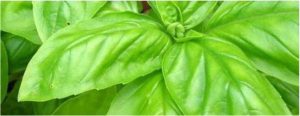BASIL, Italian Large Leaf
Geography/History:
There are many varieties of Ocimum basilicum, as well as several related species or species hybrids also
called basil. The type used in Italian food is typically called sweet basil, as opposed to Thai basil, lemon
basil (O. X citriodorum) and holy basil (Ocimum tenuiflorum), which are used in Asia. While most common
varieties of basil are treated as annuals, some are perennial in warm, tropical climates, including holy basil and
a cultivar known as ’African Blue’. Basil is originally native to India and other tropical regions of Asia, having
been cultivated there for more than 5,000 years.
Nutritional Value:
Basil is a very good source of vitamin A (through its concentration of carotenoids such as beta-carotene).
Called “pro-vitamin A,” since it can be converted into vitamin A, beta-carotene is a more powerful anti-oxidant
than vitamin A and not only protects epithelial cells (the cells that form the lining of numerous body structures
including the blood vessels) from free radical damage, but also helps prevent free radicals from oxidizing
cholesterol in the blood stream.
Spacing: 6-8in (15-20cm)
Height: 24-30in (60-75cm)
Width: 12in. (30cm)
Exposure: Full Sun – 6+ hours direct sun
Sowing Method: Start Indoors
Planting/Growing Tips:
Basil can be planted outdoors after the danger of frost has passed.
• Choose a sunny location (6+ hours of sun) and dig a hole about two times as wide as your pot.
• Remove your plant from the pot by loosening the soil and tipping it out into your hand. Place your plant in the
soil about as deep as it was in the pot.
• Refill the space around your plant with soil and press lightly to compact the dirt, keeping your plant firmly in
the ground.
• Water immediately to settle the soil, and add more soil as needed, bringing it level to the rest of your garden.

